The Production Process Of The Graphite Electrode
Graphite electrode is a kind of high temperature resistant graphite conductive material produced by using petroleum coke, needle coke as aggregate, coal asphalt as binder, after a series of processes such as mixing, molding, roasting, dipping, graphitization and mechanical processing.

The main production processes of the graphite electrode are as follows:
(1) Calcination. Petroleum coke or asphalt coke need to be forged, and the calcination temperature should reach 1300℃, so order to fully remove the volatile content contained in carbon raw materials, and improve the true density, mechanical strength and electrical conductivity of coke.
(2) crushing, screening, and ingredients. The calcined carbon raw materials are broken and screened into aggregate particles of the specified size, part of the coke is ground into fine powder, and the dry mixture is concentrated according to the formula.
(3) Mix. In the heating state, the quantitative dry mixture of various particles is mixed with the quantitative binder, mixed and kneaded to synthesize the plastic paste.
(4) molding, under the action of external pressure (extrusion forming) or under the action of high frequency vibration (vibration forming) to press the paste into a certain shape and high density of raw electrode (billet).
(5) Baking. The raw electrode is placed in a special roasting furnace, and the metallurgical coke powder is filled and covered with the raw electrode. At the high temperature of the bonding agent of about 1250℃, the roasting carbon electrode is made.
(6) Immaculate. In order to improve the density and mechanical strength of the electrode products, the roasting electrode is loaded into the high voltage equipment, and the liquid dipping agent asphalt is pressed into the air hole of the electrode. After immersion, the roasting should be carried out once. According to the performance requirements of the product, sometimes the impregnation and secondary roasting should be repeated 23 times.
(7) graphitization. The baked carbon electrode is loaded into the graphitization furnace, covered with the insulation material. By using the heating method of direct electrification to produce high temperature, the carbon electrode is converted into graphite electrode with graphite crystal structure at the high temperature of 2200~3000℃.
(8) machining. According to the use requirements, the graphite electrode blank surface turning, flat end surface and screw holes for connection processing, and the joint for connection.
(9) The graphite electrode shall be properly packaged after passing the inspection and sent to the user.
Post time: Jun-01-2023






